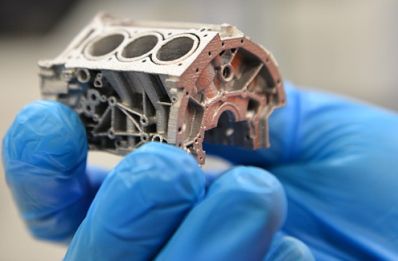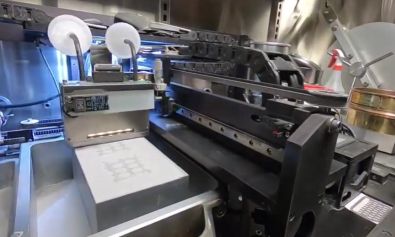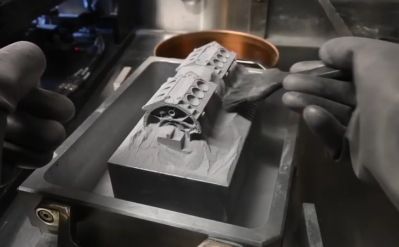Breakthrough in Making 3D Printed Parts for the Auto Industry
In a project co-funded by Ford and the ExOne Company, a team of engineers, material scientists, and manufacturing experts has developed a patent-pending process for rapid and reliable binder jet 3D printing and sintering of complex parts made of aluminum 6061 -- one of the most commonly used aluminum alloys in the world.

This engine block model, 3D printed in 6061 aluminum, demonstrates the high resolution and geometric control that can be produced in a new patent-pending binder jet 3D-printing and sintering process developed by Ford and ExOne.
Delivering a commercially viable achievement in this area has evaded researchers for more than a decade. Some aluminum alloys can be 3D printed today using lasers, but the process is much slower than the one developed by Ford and ExOne. Collaborative and individual patents are expected to be filed by Ford and ExOne as a result of this ongoing project.
The new process is expected to increase Ford's efficiency by allowing the company to affordably produce complex parts uniquely designed for additive manufacturing, which enables size and weight reductions, part consolidation, and performance improvements.
VIDEO: ExOne and Ford deliver an automotive industry first: binder jet aluminum printing with high-density sintering.
"This is a breakthrough in making 3D-printed and sintered parts for the auto industry," said Harold Sears, Ford technical leader for additive manufacturing. "While the 3D-printing process is very different than stamping body panels, we understand the behavior of aluminum better today, as well as its value in lightweighting vehicles. High-speed aluminum 3D printing paves the way for other opportunities that we're just now starting to take a look at because of the ability to do complex parts with aluminum that previously weren't possible. It's really opening doors for other opportunities."
The new innovation came about through the process of binder jetting, widely regarded as one of the fastest methods of metal 3D printing for high-volume output. It uses a digital file to quickly inkjet a binder into a bed of powder particles such as metal, sand, or ceramic to create a solid part, one thin layer at a time.

Binder jet 3D printing uses a digital file to quickly inkjet a binder into a bed of powder particles to create a solid part, one thin layer at a time.
When printing metals, the final bound metal part must be sintered in a furnace to fuse the particles together into a solid object. The heating process reinforces the strength and integrity of the metal, and while the process for sintering stainless steel is well understood, achieving high densities greater than 99% is an industry breakthrough for aluminum.
This Ford-ExOne joint development project was first initiated in 2019. Ford has led the final material and repeatability testing to verify its accuracy. The cross-functional Ford-ExOne team is actively working on designs to use the new material and process.
The relationship between Ford and ExOne goes back to the early 2000s, when Ford purchased several of ExOne's first industrial sand 3D printers in the United States to create sand molds and cores for metal casting. ExOne 3D printers are among a wide range of technologies featured in Ford's Advanced Manufacturing Center in Redford, MI, with additional ExOne printers in Ford's U.K. facilities.

The binder jet 3D printing should enable Ford to affordably produce complex parts uniquely designed for additive manufacturing.
To date, ExOne has now qualified 23 metal, ceramic, and sand materials for use on its industrial binder jetting printers. With the addition of aluminum, that now includes 12 single-alloy metals. Titanium is now fast-tracked for qualification in partnership with a global medical device company.
Because ExOne technology can 3D print almost any powder, the company has a tiered material qualification system. This system signifies the varying levels of material property results that parts 3D printed with its technology will deliver. The levels help manufacturing customers understand whether ExOne binder jetting technology could meet their specific application needs:
- Third-Party Qualified: The material has passed rigorous ExOne tests over multiple builds and has verified material property data from an independent third party. These materials meet MPIF, AMS, or other material standards.
- Customer-Qualified: These materials have been qualified by ExOne customers with their own standards and are being successfully printed today for their own applications. However, they have not yet earned ExOne's highest level of qualification for general market readiness. ExOne routinely partners with manufacturers to develop materials for specific applications.
- R&D Materials: These materials have been deemed printable by ExOne and select customers after preliminary analysis. R&D work for these materials is ongoing and involves engineering work with the materials, ExOne printers, and ExOne processes to ensure successful printing.
Want more information? Click below.
Rate this article
View our terms of use and privacy policy ::m::